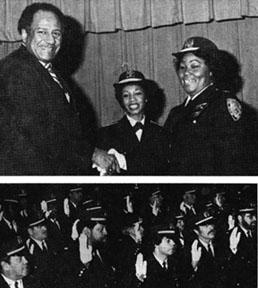
| | February 1980 Inside Out caption: PROMOTION DAY
Commissioner Benjamin Ward and Chief of Operations Jacqueline McMickens presided over promotional ceremonies at the Correctional Institution for Women on Jan. 11. Those promoted were Deputy Wardens John Incledon. and George Cruz, Assistant Deputy Wardens James Garvey, James Rosas, Vincent Romeo, James Weren and Stanley Boyd and Captains Julius Lesser, John Davis, George Benjamin, Marron Hopkins, Samuel Scarola, David White, William Daly, Raymond Molinaro, Frank Bruni, Vernon Marshall, Leonard Delman, Gerard Falls, Anora Jiles, Arthur Sosa, Anthony Critelli, Mary Marshall, Michael Dillon, Willie Crosby, Walter Johnson, Judy Schlessinger, Angela Paduani, Marion Smith, Joan Kral and James Barlow. |
From May 1980 Inside Out:
COMMISSIONER'S CORNER
by Benjamin Ward
RE-SECURING RIKERS
Since 1975 a total of 95 inmates have escaped from institutions on Rikers Island.
It is almost beside the point that most of them were recaptured and that more of the rest died trying to make good their escape than reached ultimate freedom. The real problem, from the standpoint of the authorities charged with administering this city's jails, is that those 95 inmates believed they had a reasonable chance to escape from Rikers Island. That is the real crux of the security problem presented by Rikers Island today.
When I took charge of the New York City Department of Correction last August, my two predecessors, Ben Malcolm and Bill Ciuros, each outlined the problem of Rikers' vulnerability to me. But even that did not prepare me for what I found on what is ostensibly a "maximum security" prison island. After all, during 1977, my last full year as Commissioner of Correctional Services of New York State, our seven major maximum security institutions had suffered a combined total of one escape.
When the old Rikers Island Penitentiary was completed in 1933, the Island was considered virtually escape-proof. And that became the basis of its downfall.

| | October 1980 Inside Out caption: Commissioner Benjamin Ward, right, and 1st Deputy Commissioner Mark Corrigan during the Managerial Conference.
[Held in May at NYU, it was the first in a series of day-long conferences devoted to the accountability policies and practices.] |
Confident that no inmate could swim the torrential waters of the East River, the City was lax in its design of perimeter security for the penitentiary and the five other institutions that were added to the Island complex.
We have started to change that now. A contract has been let for increased perimeter security around the Adolescent Reception Detention Center, including the deployment of a microwave alarm system. Another project about to begin will encircle the House of Detention for Men with an even stronger ring of security. Eventually, every one of the Rikers Island institutions will have to be so secured -- at a cost the State is prepared to bear if the City agrees to lease the Island to the State, which has promised to reimburse the City for the current work and to completely restore the Island to true "maximum- security" status.
A variety of factors combined to render Rikers Island vulnerable to escape attempts.
The completion, in 1966, of a bridge connecting the Island to Queens was absolutely necessary for accessibility, but it provided one immediate escape access and led to a second by slowing down the East River currents. By then, Runway 22 at LaGuardia Airport already had been extended across the deep channel around the Island. Thus, at a point in the river that was no longer very swift, an inmate who made it to the water's edge now had an apparently attainable target on the mainland. And, to the north, the City had abandoned North and South Brothers Islands, providing the escapee with a way-station for rest and hiding en route to the Bronx if he chose that direction.

| | October 1980 Inside Out caption: Commissioner Benjamin Ward, right, Captain Patricia Thomas, center, and Warden Frank Colavito during CIFW's Family Day.
[Held on July 7, it was the first Family Day picnic for inmates and their families at the Correction Institutions for Women on Rikers.] |
And at a time when the individual integrity of the Island's institutions had become all the more important, two other factors were limiting the Department of Correction's ability to secure them properly. First, as a result of the City's changing role, the Department was forced to house more and more unconvicted detainees on Rikers Island. These inmates are entitled to far greater public access than sentenced inmates and that has led to a greater flow of contraband, including tools of escape. Second, technological advances, particularly in the jeweler's trade, produced tiny saws, easily hidden and passed during contact visits, that can easily knife through the kind of steel bars we have on Rikers Island.
No maximum security state prison depends on the building itself for its prime source of security. High fences, topped with forbidding "razor ribbon" and manned by armed patrols, tell the inmates that even if they saw their way out of a cell, their path to freedom is still a very difficult one. And, thus, few try.
The prospect that more will try to leave Rikers Island this summer so concerns me that I have moved to strengthen security there in other ways, too. Armed officers now surround the House of Detention for Men during evening hours. A boat with a shallow enough draft to allow it to traverse the scant strip of river between the Island and the airport runway has been purchased from federal surplus stock and will be patrolling the water within weeks. 
| | October 1980 Inside Out caption: ANCHORS AWEIGH
Officers assigned to patrol the waters around Rikers Island check their navigation charts and then take to the high seas of the East River on new DOC patrol boat that was purchased for $500 under a Federal Surplus program. Boat hasn't had the chance to track down any escapees yet, but it has rescued a drowning civilian near La Guardia Airport.
|
Security of the bridge has been tightened and an auxiliary unfenced employees' parking lot has been closed; City Department of Traffic experts have been consulted with an eye toward devising even tighter security without hampering the flow of traffic. The first of a series of field audits into institutional performance has been completed at our Adolescent center and other audits will be commenced shortly.
But these are essentially stop-gap measures. Ultimately, we know what has to be done to permanently re-secure Rikers Island. Each of those institutions has to be given an impregnable security perimeter of its own, as if it were down the block instead of out there on that East River island. Confronted with a similar situation four years ago when we took control of the Arthur Kill institution on Staten Island from the old State Narcotics Addiction Control Commission, we in the State Department of Correctional Services built double fencing, topping with razor ribbon and surrounded by armed patrols. Under NACC, Arthur Kill had been a virtual sieve. Under the DOCS it has not suffered a single escape since I installed a secure perimeter. The inmates know better than to try.
If Rikers Island is leased to the State, even more sophisticated fencing will be put in place before state prisoners are brought to the Island. Microwave screening systems will be linked to computers, so that alarms will be triggered the moment an inmate enters the space between the two fences that will be built around each institution.
This of course, will take money and the State had pledged to spend $110 million to bolster the present plant on Rikers Island. There are many reasons to be in favor of the lease proposal --including the argument that the island was never designed to be a jail, housing unconvicted city detainees, in the first place. But no argument for the Rikers Island transfer is more compelling than this one: When the State takes over, Rikers Island will again be a maximum security facility.
|